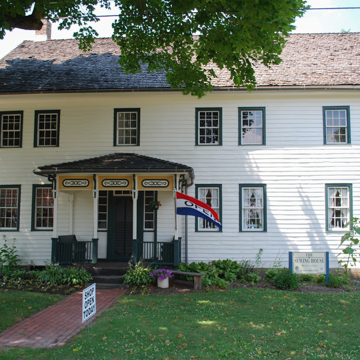You are here
Sewing House
The Society of Separatists of Zoar founded the village of Zoar in 1817 and prospered there until 1898, when they dissolved their communal way of life. The Zoarites were a religious utopian society dedicated to creating an environment that supported their communal lifestyle and reflected their Germanic traditions in buildings (both stylistically and in materials and construction methods) and agricultural landscape patterns derived from the European Middle Ages.
Built in 1850, the Sewing House originally served as a residence, but it also contained three rooms for communal sewing activities and a cloth storeroom. The Zoarites distributed the clothing they produced here among their members as part of their communal existence, rather than having individuals make their own clothes, as was typical of the era. The clothes produced at the Sewing House were plain, nearly uniform-like attire, which made the Zoarites stand out from most of their neighbors in northeast Ohio. Zoarites also patched and mended clothes in the Sewing House, and offered these services to guests in the village’s hotels.
The clapboard house has an asymmetrical seven-bay facade. The entrance is emphasized by a transom and sidelight surround. A single-bay porch covers the entrance. The building has a vaulted stone cellar, a Germanic architectural feature that provided storage space and remained temperate year round. The Sewing House is one of at least eighteen buildings in Zoar equipped with a vaulted stone cellar.
The Sewing House was included in the Historic American Building Survey’s documentation of Zoar in 1937 and it is part of the Zoar Historic District, designated a National Historic Landmark in 2016. Today, gift shops occupy the building.
References
Avdakov, Steven, Debbie Griffin, and Nathalie Wright, “Zoar Historic District,” Tuscarawas County, Ohio. National Historic Landmark Nomination, 2016. National Park Service, U.S. Department of the Interior, Washington, D.C.
Fernandez, Kathleen M. A Singular People: Images of Zoar. Kent, OH: Kent State University Press, 2003.
Hinds, William Alfred. American Communities. Rev. ed. Chicago: Charles H. Kerr and Company, 1902.
Morhart, Hilda Dischinger. The Zoar Story. Dover, OH: Seibert Printing Company, 1967.
Nixon, Edgar Burkhardt. “The Society of Separatists of Zoar.” Ph.D. dissertation, The Ohio State University, 1933.
Nordhoff, Charles. Communistic Societies of the United States. New York: Harper and Brothers, 1875.
Robison, Elwin C. “Heavenly Aspirations and Earthly Realities: Four Northeast Ohio Religious Utopias.” Timeline17, no. 6 (November/December) 2000: 2-25.
Writing Credits
If SAH Archipedia has been useful to you, please consider supporting it.
SAH Archipedia tells the story of the United States through its buildings, landscapes, and cities. This freely available resource empowers the public with authoritative knowledge that deepens their understanding and appreciation of the built environment. But the Society of Architectural Historians, which created SAH Archipedia with University of Virginia Press, needs your support to maintain the high-caliber research, writing, photography, cartography, editing, design, and programming that make SAH Archipedia a trusted online resource available to all who value the history of place, heritage tourism, and learning.














